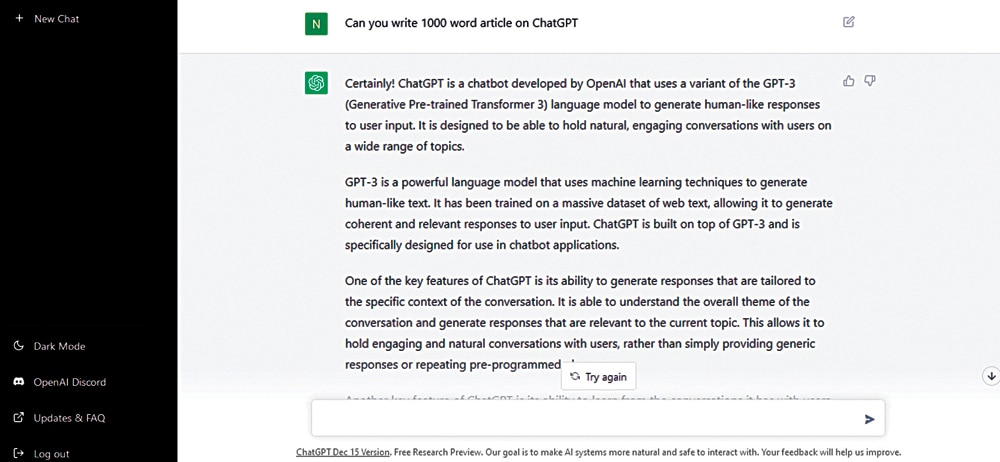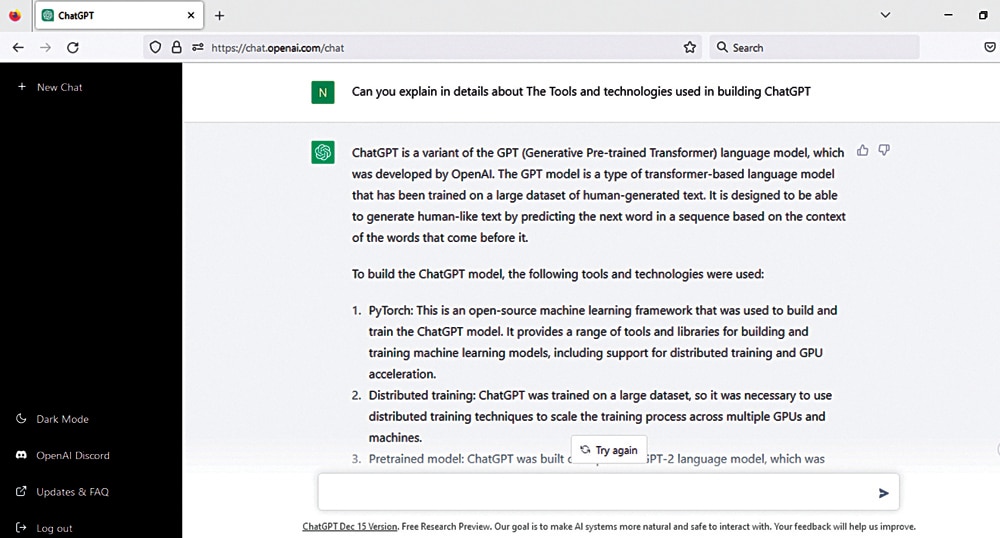The capabilities of this chatbot are shocking! What’s next?
ChatGPT is a chatbot developed by OpenAI that uses a variant of the GPT-3 (Generative
Pre-trained Transformer 3) language model to generate human-like responses to user input. It is designed to be able to hold natural, engaging conversations with users on a wide range of topic.
GPT-3 is a powerful language model that uses machine learning techniques to generate human-like text. It has been trained on a massive dataset of web text, allowing it to generate coherent and relevant responses to user input. ChatGPT is built on top of GPT-3 and is specifically designed for use in chatbot applications.
One of the key features of ChatGPT is its ability to generate responses that are tailored to the specific context of the conversation. It is able to understand the overall theme of the conversation and generate responses that are relevant to the current topic. This allows it to hold engaging and natural conversations with users, rather than simply providing generic responses or repeating pre-programmed phrases.
Another key feature of ChatGPT is its ability to learn from the conversations it has with users. As it converses with users, it can use machine learning techniques to improve its understanding of language and become more adept at generating appropriate responses. This allows it to continually improve over time and become a more effective chatbot.
One potential use for ChatGPT is as a customer service chatbot, where it can assist customers with questions and problems related to a specific product or service. It could also be used as a general-purpose chatbot for social media platforms or messaging apps, allowing users to have natural conversations with a virtual assistant.
| How To Use ChatGPT? |
| Below are some details on how an article can be written using ChatGPT: 1. Go to https://chat.openai.com/auth/login and sign up. Provide either your email ID and password, or use your Google or Microsoft account.  2. After signing up, you will see the dashboard shown below… 2. After signing up, you will see the dashboard shown below…  3. Start interacting with the bot as shown below: 3. Start interacting with the bot as shown below: 4. The two images below demonstrate how ChatGPT replies to your queries. And, how we made it produce this article. 4. The two images below demonstrate how ChatGPT replies to your queries. And, how we made it produce this article.   |
Another potential application for ChatGPT is as a language learning tool. By engaging in conversations with ChatGPT, users can practice their language skills and improve their fluency. ChatGPT could also be used as a language translation tool, allowing users to communicate with people who speak different languages by translating their messages in real time.
In conclusion, ChatGPT is a powerful chatbot that uses the GPT-3 language model to generate human-like responses to user inputs. It is able to hold natural and engaging conversations with users on a wide range of topics, and is capable of learning and improving over time. With its ability to tailor responses to the specific context of the conversation and its potential applications as a customer service chatbot, language learning tool, and translation tool, ChatGPT has the potential to revolutionise the way we communicate with chatbots.
[signinlocker id=”87626″]
The technology used
ChatGPT is a variant of the GPT (Generative Pre-trained Transformer) language model, which was developed by OpenAI. The GPT model is a type of transformer based language model that has been trained on a large dataset of human-generated text. It is designed to be able to generate human-like text by predicting the next word in a sequence based on the context of the words that come before it.
To build the ChatGPT model, the following tools and technologies were used:
- PyTorch. This is an open source machine learning framework that was used to build and train the ChatGPT model. It provides a range of tools and libraries for building and training machine learning models, including support for distributed training and GPU acceleration.
- Distributed training. ChatGPT was trained on a large dataset, so it was necessary to use distributed training techniques to scale the training process across multiple GPUs and machines.
- Pretrained model. ChatGPT was built on top of the GPT-2 language model, which was trained on a large dataset of human-generated text. The GPT-2 model was used as a starting point, and then additional training data was used to fine-tune the model for the specific task of generating chatbot responses.
- Data augmentation. To improve the performance of the ChatGPT model, data augmentation techniques were used to generate additional training data by modifying the existing training data in various ways.
- Evaluation metrics. To measure the performance of the ChatGPT model, a range of evaluation metrics were used, including perplexity, which measures how well the model is able to predict the next word in a sequence, and human evaluations, where human annotators rate the quality of the model’s responses.
Overall, ChatGPT is a complex machine learning model that was built using a range of tools and technologies, including PyTorch, distributed training, pretrained models, data augmentation, and evaluation metrics.
The capabilities
ChatGPT has been specifically designed for conversational language generation. It is a powerful tool that can generate human-like text based on a given prompt or conversation history. Some of the capabilities of ChatGPT are:
- Generating responses to prompts. ChatGPT can generate responses to prompts or questions in a natural and coherent manner, allowing it to hold conversations with users.
- Maintaining context and coherence. ChatGPT is able to maintain context and coherence in a conversation, allowing it to generate responses that are relevant to the conversation and follow its flow.
- Generating diverse responses. ChatGPT is able to generate diverse responses to a given prompt, allowing it to provide a range of options or viewpoints on a topic.
- Generating personalised responses. ChatGPT can generate personalised responses by incorporating information about a user or a specific topic into its responses.
Overall, ChatGPT is a powerful tool for generating natural and coherent text for use in conversational systems, chatbots, and other applications that require the ability to generate human-like responses.
The future of conversational AI
Conversational AI, also known as chatbots or virtual assistants, is a rapidly evolving field with a lot of potential for growth and development. Here are a few areas where we may see advances in the future:
- Improved natural language understanding. Chatbots and virtual assistants will continue to get better at understanding and interpreting human language, allowing them to have more natural and engaging conversations.
- Increased personalisation. As chatbots and virtual assistants gather more data about their users, they will be able to tailor their responses and recommendations more specifically to individual needs and preferences.
- More complex tasks. Chatbots and virtual assistants will be able to handle more complex tasks and provide more comprehensive support to users. This could include tasks such as booking travel, managing finances, and more.
- Integration with other technologies. Chatbots and virtual assistants will likely become more integrated with other technologies, such as smart home devices and wearable technology. This will allow them to provide even more personalised and convenient support to users.
Overall, the future of conversational AI looks bright, with many exciting developments and opportunities on the horizon.
Who’s The Author?
You might have found the content interesting to read and may have created a view that the author has deep knowledge of the subject but needs to improve on the writing style. Hold on….the article is not authored by any human being. It has been compiled word to word (with very little editing) from the chat interaction with ChatGPT. The complete article was written in less than 5 minutes by ChatGPT!







